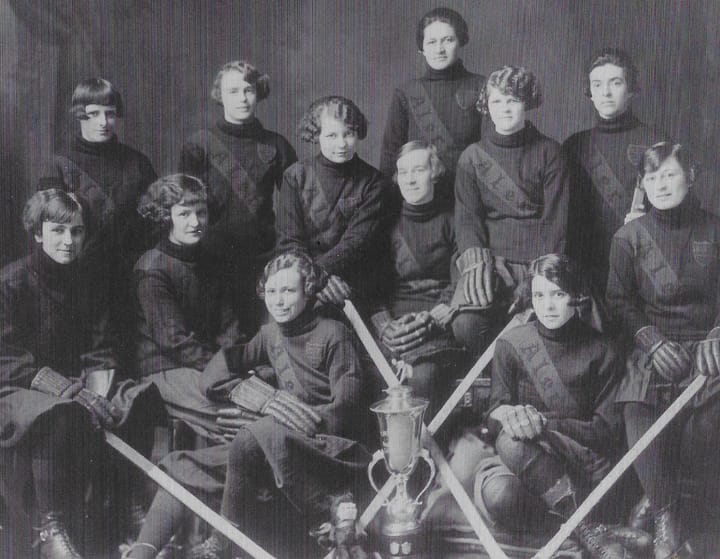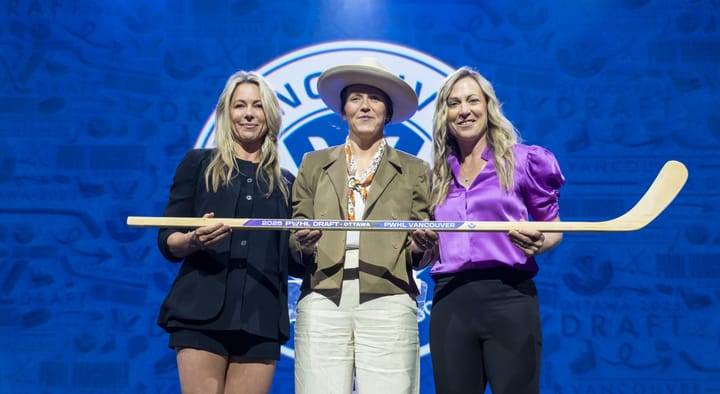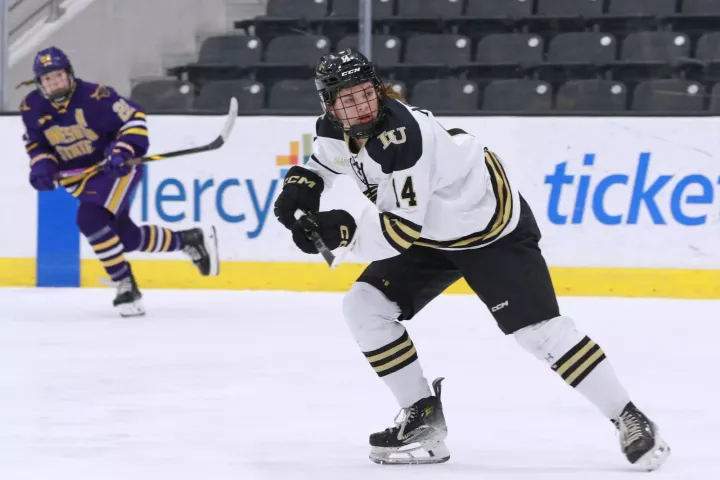Origins: The story of Karen Koch, the first woman to be paid to play
"She’s got a lot of guts...It's hard to believe a girl would just stand there and let us shoot at her. She's not scared."
Long before NWHL founder and commissioner Dani Rylan established the first professional women’s hockey league that paid its athletes a salary and long before the CWHL made its pledge to pay its players, there was a teenager in Michigan named Karen Ann Koch.
She Can Play
In October 1969, Koch (pronounced “Cook”) was an 18-year-old freshman enrolled at Northern Michigan University. She chose NMU for a reason: the school was located in Marquette, Michigan, where the Marquette Iron Rangers played in the USHL.
That October Koch traveled to the old Palestra Ice Arena in Laurium, Michigan. She stepped onto the ice under the arena’s infamously poor lighting in full goalie gear to join a group of athletes who had arrived for open try-outs for the Iron Rangers.
Koch wasn’t there as a stunt. She wanted to make the team, even though she knew the odds were stacked against her.
Koch was competing against Brian Lunney (on loan from the Toronto Maple Leafs), a promising young local goalie and a third USHL hopeful that was in direct competition with Koch. As expected, Lunney was solid; he was to be the team’s starting goaltender in its bid to defend its championship. One of the two try-out goalies “couldn’t stop a basketball with a snowshoe.” The other goalie, Koch, looked small but surprisingly quick.
Leonard “Oakie” Brumm, the Iron Rangers head coach, reflected on the memorable try-out in an article for Wisconsin Hockey News in August, 2000.
I thought to myself, ”A girl goalie... what if she gets hurt? Where is she going to change clothes? Just how good is she?” For one of the few times in my life I didn't know what to do. She had done nothing to justify cutting her. So I told her we should see how well she did and that she'd be given a fair tryout.
Brumm wasn’t aware that Koch was a young woman until the team’s captain, Barry Cook, pointed it out to him. Koch had been turned away by senior teams in the Detroit area because of her gender.
At first glance, Koch was simply a 5-foot-5 goalie. She was small, but she was also as fearless in net as players who were more than half a foot taller than her.
“I’d just like to play without anyone knowing.” -Koch
Brumm was impressed by the undersized netminder, but many of his players weren’t. Concerns about having a woman in the dressing room were raised by Iron Rangers players. Her teammates jeered Koch early on, calling her “boy” and “son” and likely other terms that weren’t fit for publication (even in 1970).
“It’s always the girl goalie, you know,” Koch explained while being interviewed in a profoundly sexist article that ran in the Spokesman-Review in January of 1970. “The players have this thing... ‘I hope you brought your towel... what happens in the locker room?’ You know, stuff like that.”
Koch earned their respect the hard way - by standing between the pipes in practice and stopping shots from players who outweighed her by at least 50 pounds.
"She’s got a lot of guts,” Marquette left winger Robert Caster admitted. “It's hard to believe a girl would just stand there and let us shoot at her. She's not scared."
Goaltending in the late 1960s and early 1970s was largely for daredevils. Andy Brown was the last NHL goaltender to play without a helmet in 1974. A goaltender’s pads left a lot to be desired. It was not uncommon for goalies to leave a game after enduring an injury from a shot that found an unprotected area.
Brumm recognized an opportunity for publicity when he saw it.
When the time came for Brumm to make his final cuts, he elected to dress a roster of 17 skaters and three goalies. The third goalie to make the team was Koch. She signed a contract for $40 per game, which almost certainly made her the first professional female player in the world.
At the time salaries in the USHL ranged from $25 a game to as much as $100 a game. Koch joked to the media that she wouldn’t be able to retire on how much she made, but the amount wasn’t nearly as important as what the paycheck meant. She was a professional hockey player.
“I told the coach I was a girl at the first practice,” Koch shared with the Pittsburgh Press two months after making the team. “The league had financial troubles and Coach Brumm thought I might be able to help, so he said it was okay to try out.”
The Reluctant Star
Fame was never what Koch was after. In fact, she believed that playing in front of a crowd was the hardest part for her. Koch took a tranquilizer before each game to help with her anxiety.
“I’d just like to play without anyone knowing,” she explained in that same interview. “Really, on the ice, I don’t look like a girl. Really, I don’t. I have short hair.”
Koch tried out for the Iron Rangers because she loved hockey. Press clippings from articles that followed her unique journey include a photograph taken of her studying in her dorm room wearing a Blackhawks jersey. She studied for her classes at NMU surrounded by walls covered in pictures of NHL players.
“I’d actually play hockey for nothing,” Koch admitted. “I want to play, I want to learn. Actually I’d almost pay [the Iron Rangers] to play.”
At first Marquette had issues arranging appropriate facilities for her to dress before games, leaving Koch watching from the stands. Eventually, arrangements were made that worked for Koch and her teammates. Any lingering objections to her being on the team from unconvinced players on Marquette were quickly overshadowed by the publicity that Koch brought to the USHL.
She signed a contract for $40 per game, which almost certainly made her the first professional female player in the world.
Koch made her debut in relief of Lunney during an exhibition game. According to one source, in her first three periods of professional hockey she stopped every shot she saw.
Koch was no gimmick. She could play.
But that didn’t stop the USHL and her team from treating her like something of a sideshow. At the 1969-1970 Iron Rangers season opener in Sault St. Marie, Ontario, a spectacle was arranged. The mayor of Sault St. Marie was once a well-known hockey player. So the city staff arranged for him to take a penalty shot against Koch before the game and begged Brumm to announce her as the starting goalie.
In front of a raucous crowd, she stopped the mayor cold. She received a standing ovation and the mayor was met with an avalanche of boos when he returned to the stands.
Koch went on to stop 10 of 12 shots she faced before Brumm replaced her after the first period. Marquette won that game 5-3, but all anyone wanted to talk about was the Iron Rangers female goalie.
Suddenly, Iron Rangers games were a hot ticket. During a game in Green Bay, the auxiliary police force had to be called in to help handle the swelling group of spectators. At times Brumm would name Koch the starting goaltender just to help sell tickets, even if he was actually starting Lunney. Everyone wanted to see Marquette’s famous “Girl Goalie.”
But Koch’s time in the USHL was short-lived. The same fearlessness that let her stand in front of the slap shots of grown men also proved to be a problem.
Without Fear
The team’s popular young goaltender felt that she saw the puck better without a mask despite the danger it put her in. In press clippings from her time with the Iron Rangers a scar beneath her left eye is visible. That scar was a result of ten stitches she needed to fix a gash left by a slap shot from her father’s stick two years before her USHL debut.
Brumm had been eager to protect his rookie goalie. He ordered a mask for her and some 40 pounds of specialized equipment to keep her protected between the pipes. By Christmas Koch had stopped wearing her mask altogether, despite earning a black eye from a practice injury earlier in the season.
Unfortunately, she seemed to have a "death wish" for a facial scar caused by a hockey puck in a USHL game. She simply and consistently defied my orders to wear a mask while playing.
With about 10 games left in the schedule, Brumm released his third goaltender. He just couldn’t reconcile Koch’s devil-may-care attitude with the attention that she brought to the the team.
The Iron Rangers went on to win the USHL Championship that year. Koch eventually took her talents to Canada in the Toronto area, but was barred by the Canadian Amateur Hockey Association from playing in games with men. Before it truly had a chance to begin, her career in men’s hockey was over.
Outside of Brumm’s piece in the Marquette Monthly that ran in 2000, very little has been written or said about Koch since she made history. Brumm passed away in 2006. The Iron Rangers are now defunct, and so too is the team’s website.
Searching for information about Koch and her life after her time in the USHL is like looking for breadcrumbs on the beach.
Her post-hockey career is summed up on Wikipedia in three sentences:
Since her hockey days, she has earned a bachelor's and a master's degree, both in English Literature, from Wayne State University and the University of Dayton respectively. She holds a black belt in judo and a brown belt in jujitsu. Karen loves birds and all creatures of the wild.
The Ice Garden has chosen not to reach out to contact Koch about an interview and to respect her right to live a private life.
Koch made her USHL debut 23 years before Manon Rhéaume appeared in exhibition games with the Tampa Bay Lightning. Her player profile page on hockeydb.com features a press photo of her smiling, but none of her stats have been preserved. To say the least, the page lacks detail. It does, however, offer an appropriate summary of a young woman who made history in Michigan two years before Cammi Granato was born:
Karen Koch, Goalie.





Comments ()